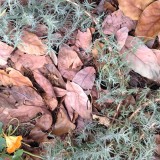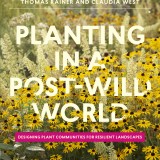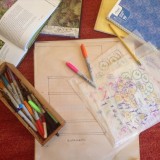
A bit of our own loving–if not very tidy- landscape
A post in our Back to the Garden series, organized under the “back to the garden” tag
So, let’s say we want to play nice with the rest of nature. Let’s say we want public parks, yards and gardens which exist for more than show, spaces which support a diversity of life, steward our resources wisely and are a joy to the eye. We’ve got to change the existing lifeless paradigm of lawn and hedge and disposable annual flowers.
How do we do that? What does that look like?
Well, the how part is going to take a few posts to explain–but we can start with what it might look like.
The fantastic thing about this new landscaping paradigm is that it is entirely local. If we remove the heinous, homogeneous, ubiquitous lawn from our tool box, suddenly a yard in Santa Fe looks quite different than a yard in Michigan or a yard in Florida. We return, after a long period of delusion, to the realm of common sense.
Because the new landscapes are entirely local, I can’t even begin to list or imagine all the possibilities, but here are a few of the images I see when I think about a better future:
First, in terms of public space, I have to bring up Piet Oudolf, though we’ve blogged about him before.
Here’s his work in Chicago’s Millennium Park:

Chicago’s Millennium Park’s Lurie Garden by Piet Oudolf and Kathryn Gustafson”Milpark” by Dan Hiris. Licensed under CC BY 2.5 via Wikimedia Commons
Now, isn’t that better than a vast lawn?
Can’t you just hear the hum of insects and the song of birds?
One thing I really like about Oudolf’s work is that it is designed to evolve with the seasons. Plants are allowed to flower, seed and go dormant, and the dead stalks are appreciated as part of the fall/winter landscape. This is so important, because when we deny the “less attractive” life stages of plants, we also deny our fellow creatures food and habitat in the form of seeds, stems and roots.
And, of course, Oudolf is well known for doing the planting design at the High Line park in New York, a mile and half long section of abandoned elevated train track which first, was transformed by nature into a sort of secret park known only to urban explorers–and then, beginning in 2006, was refashioned into a much loved public attraction by a team of architects and designers.
If you can get your hands on Walking the High Line by Joel Sternfeld, it’s well worth a look to see how nature had gained a strong foothold in on the train tracks before the designers moved in, even though she had to work high in the air on a thin layer of soil:

The human designers echoed nature’s original work in the High Line:

The High Line in Manhattan at West 20th Street by BeyondMyKen courtesy of Wikimedia Commons
There are many beautiful photos of the High Line on the Internets, but I can’t put any of them up here without being all creepy and infringy. I highly encourage a quick image search so you can see the garden in all seasons. As a start, check out these images at Gardening Gone Wild.
***
Okay, so that’s all very well for the professionals and for big parks, but how does this work in smaller spaces?
I think it can work very well. We just have to cast our imaginations back in time before the invention cheap artificial fertilizers and weed killers–not to me the lawn mower–made a carpet of turf the universal default setting in home gardens. What this pre-lawn world looked like, exactly, varied by region.
For temperate climates, one classic mode is the cottage garden, a riot of blooming flowers and herbs:

Anne Hathaway gardens 2007, by Pessimist – Own work. Licensed under Public Domain via Wikimedia Commons
In dryer climes, there’s the Moorish style garden, which also has echoes all over the Mediterranean.
Basically this style of garden emphasizes hardscape for the humans, having plenty of paths and benches and fountains, while the edges of the built areas are planted thickly with climate appropriate plants, often with an emphasis on fruit trees and herbs. Though it is human dominated, it is not hostile to other life–birds have places to roost and bathe, and lizards can sunbathe on the pavement– and it can host a great diversity of plants, which pleases the pollinators.
The photo below is a corner of a larger garden, but could just as easily be the design of a small yard:

Moorish Garden at Tohono Chul in Tuscon, AZ by DesertCorner. Courtesy of Wikimedia Commons
Here’s a pic of a beautiful, lawn-free, Southern California landscape which I took on the Theodore Payne Native Plant Tour . If you’re interested in using California natives, check out the tour website. Lots of photos to inspire you!

Garden #4 of the 2015 Theodore Payne Native Plant tour, located in Highland Park, CA
I really liked this little cottage’s yard because it shows that crafting a loving landscape doesn’t have to be a big, complicated deal. This yard is tiny, but so welcoming to both people and wildlife. (See more details here)
That bush with the red flowers by the porch is called a fairy duster (Calliandra californica), and insects just love, love, love this plant. I wish I had room for one in my yard. (Maybe when one of our fussy fruit trees dies….)
There are also wildflowers, which come and go on their own, and tough-as-nails sages which feed both insects and birds. There’s a little bird bath just out of the frame–water is a gift in this climate. In addition, the gravel walk is permeable as is the mulch in the garden, so the soil can drink in the rainwater. The mulch will also improve the soil, and host invisible life underground.
And that’s our friend David Newsom trying to sneak off the edge of the picture. It’s appropriate that he’s in this post, because he has a great garden himself, and he’s also trying to get the word out about loving the land and the importance of protecting insects such as the honeybee and the monarch.
For the heck of it, here’s another shot of the same yard, just a little more to the right, so you can see the birdbath. I love the mulch. Mulch means good things, like less work and more worms.

Detail of garden #4 of the 2015 Theodore Payne Native Plant tour, located in Highland Park, CA
***
Another person I think about when I consider a living landscape is Brad Lancaster. If you don’t know him and his work, go and get to know him now.
I saw Brad speak several years ago, and in that talk he described how he had moved into a run-down neighborhood in Tuscon, a place where the landscape was dry and dead, and began to transform his yard and the street area by capturing the rainwater, mulching and planting trees.
Along the way, the neighbors began asking for help with their yards and over time, the whole neighborhood has become a little slice of paradise, a shady oasis full of edible trees like pomegranate and mesquite. He said wild animals, like quail, are even moving back in.
I still remember the pictures from his presentation, but I’m having a hard time finding anything like them to share with you. I’ve shamelessly screen grabbed a still from a nice short video about Brad and rainwater harvesting, called Free Water, by Andrew Brown. I will share this video again later in this series, and we’ll talk more about Brad, too.
In the meanwhile, though the images are not of best quality, look at the lushness of this landscape. This was all done at low cost with basic materials, working smart instead of working hard. This all grew out of nothing. Believe me, there was nothing there but chain link and dust. All of the irrigation comes from rainfall:

This landscape is irrigated with water from the street flooding which comes with every rain shower.

Note the “curb cut”: the slice of curb removed near the base of the biggest tree. This allows water to flow from the street into a basin around tree.
It seems I’ve been going on for a while now, and I haven’t even scratched the surface of possible landscape modes.
What would a loving landscape look like in the tropics? In the mountains? By the sea? It could also come in the shape of a food forest or a rain garden or even a water garden.
Although the loving landscape doesn’t have to be an exclusively native landscape, a good place to start researching is with your local native plant society or in the native section of your local botanical gardens and local nature preserves. Using resources like this, you can get a feel for the vocabulary of your landscape.
You may also want to research the history of your area. What kind of landscape was there before there were houses? Was it farm? Grazing land? And what was it before it was farm or pasture?
Another good source of information is your local Audubon Society chapter. They’ll be able to tip you off as to ways to help your local birds. The Xerces Society for Invertebrate Conservation (isn’t that a great name?) is another fantastic resource. For instance, they have lists of plants which support native bees, divided by region–not just for the U.S., but for points all over the world. We’ll come back to them, later, too. For now, this is all just grist for the mill.
The thing about the loving landscape is that it does not appear overnight. It takes some contemplation. The lifeless landscape takes no more than ten minutes of thought and a quick jaunt to the nearest big box store to buy lawn seed, a bottle of Miracle Grow and rose bush. A loving landscape is a collaborative process, so you have to start off by learning who your collaborators might be. The birds and bugs and fuzzy critters are the charismatic collaborators, but your real collaborators, your indispensable allies, live beneath the ground, in the soil.
We’ll start with soil next week.






Yea Kelly! I am lovin’ your posts! I am here in the Mohave Desert and in the process of turning a barren, neglected place into a place for all the creatures. I know it can be done because I lived near Tucson for awhile and saw what could be done there. (I only wish we had the monsoons that they get.)
I am glad there are people out there who CARE and are acting on a local level to change things instead of waiting for ‘higher ups’ to take control.
Keep up those inspirational posts!
One can always tell whether or not the people designing or extolling the virtues of these fantasy yards have children. ‘Go play in the cactus patch till dinner is ready, kids!’ 🙂
I personally think most of these landscapes are great for kids. I know that my little sisters would rather play in the woods or the hedgerows than in a plain yard. These kinda I plantings can create all kind of little niches to explore, cool things to discover, bushes/tree to make forts under, etc.
You would be amazed at the variety of plants without thorns that grow in the high desert. Personally I am not fond of thorny plants. My children and grandchildren much prefer to be outdoors exploring the lizards, squirrels, and rabbits and bringing in the fresh eggs for the neighbor. Children love to explore and use their imaginations rather than have just swing-sets on lovely lawns.
Thank you for these posts. I’ve been looking forward to them every Thursday since you started. I’m working hard to remake the landscaping on our property to be both productive for us and welcoming and vibrant for other species. It’s nice to see other examples and hear from others who care, even if our climates are utterly different( I’m in michigan).
I’ve been plotting my lawns early demise for some time now, to be returned to what is called a California Coastal Sage Scrub. I found out about our plant community at http://www.laspilitas.com/nature-of-california/communities, a tremendous resource for native plants and creating a just such a garden. The addition of the Theodore Payne Native Plant Tour will help get a visual what my wife and I want to move towards. I looking forward to further installments of The Loving Landscape.
Karl- that website you linked is a treasure trove of information; a real service is being provided by the nursery which hosts it. So much more than “buy our pretty plants”! I looked up our local plant community, foothill oaks, and was fascinated to read about the importance of leaving the oak leaf litter in place- apparently there is a very specific microbial community which regulates the decomposition of the leaves, and the release of their nutrients, captured water, etc. to the oaks. Who knew? I am inspired to “clean up” the invasive weeds under our trees and replant with natives to support the oaks.
Thanks-
Heather in CA
Love this post! Last year, hubby bought a piece of land with a 250 square feet cottage. We started on a veggie garden just to have it devoured by boars. They’re a pest here and almost unstoppable. Anyway, after they ‘d eaten EVERYTHING, the garden returned to its “native” state with flowers brightening our days. Thi year we’ll just leave it to its own devices, seeing it’s doing so well!
For a while we rented a different place in Madison, WI every summer as a temporary home and studio. The best back yard we ever had there was the one that had been completely abandoned. I’m sure some of the plants were native and some were things brought in that had naturalized, but I was astonished, all summer long as soon as one flower’s season was done, something else would start blooming and it was lovely to look at the entire time.
Beautiful post and great thoughts!
Great post! Love the idea of building a living landscape friendly to creatures.
I would love to see a blog post that highlights best plantings for the dry garden in California (ugh drought), that may also be chicken-proof. So far I’ve found my chickens devour everything except the salvia!
Kelly
Great article. I love all the inspiration and resources. I agree the link from Karl is fantastic.
The place i am getting stuck with our little yard is the master plan. I have so many ideas and they are all swirling around and i can’t get out of analysis mode and it ends in paralysis. so far my solution to this is getting more information, which in turn creates more paralysis. Hmmmm.
How does one get out of trying to create the perfect combination of grey water, native, edibles, Brad Lancaster, plant guilds, hard scape, soil health, low water, and just get started. How much of a master plan is needed before you start? Is there a so coastal garden wizard that can come and and camp out in our backyard with me and life map my entire dream for the yard. leaving me with a plant list, site map, and project outline for me to tackle in my free time.
Seriously i am open to any affordable consultants that can tutor me through the process…
I am learning that i do best with a recipe or a template to help me get started and then once i feel comfortable with the template, i start changing things and the creative juices start flowing.
Sorry a bit of a rant, but all your thoughts are welcome on how to get unstuck and start realizing the dream.
Hey Seth! First, don’t panic. It is a lot to think about, and the truth is your yard will never be perfect, or “complete.” I don’t know how many iterations our yard has been through, and right now I’m not happy with it. There’s always something that could be better! So be easy on yourself. It’s fine to do one area at a time, one project at a time, and see how that goes, and let those results shape what needs to happen next.
I think professionals are great=–as little as we want to spend the extra money, professional design saves money and time in the long run. I wish we’d consulted one when we began. You’ve given me an idea. Next week we’ll do a post which is a call for garden designer recommendations by region, and I can put together a master list. I know some people here in LA, but you’re down south? You’ll need someone more local.
My friend in Birmingham has “herbs and yard art” in her yard. The city has given her various warnings and tickets for her “weeds and trash.” I have never seen her yard, but I imagine her ses affects how her lawn is perceived.
Thanks so much for this post! I’m really obsessed with this whole idea of moving my lawn and ornamental shrubs towards a wild food forest/critter habitat. I’ve applied for the Backyard Habitat certification program and will be interested to see/hear what the consultant says. There are a couple issues I’m a bit confused on, like what about plants that are non native and invasive but happen to be bee and bird magnets? Seems like the Backyard Habitat people recommend having sections dedicated to birds and beneficial critters instead of planting natives far apart from each other and mixed in with non native ornamentals. Hmmmmmmm, food for thought!
This is a controversial subject, but I think there’s room for natives and non-natives in a landscape, and room even for “invasives.” Every year I let the dreaded fennel and mustard bloom in our yard, along with the rampant nasturtium, because, yes, they’re feeding wildlife of all sorts.
Uhhh the Anne Hathaway gardens are amazing. I would much have a wild, slightly overgrow and much loved garden than a perfectly clipped lawn any day. I love seeing bits of plant life taking over the city so quietly.
Thanks Kelly,
The one step at a time and see what emerges approach has been helpful. I think in our fast paced culture it’s hard to slow down and let things evolve in due time. We have been at our house for a year and are slowly gaining confidence to start painting on the mulched canvas of our yard.
The landscape designer “Angie’s list” is a great idea. Though a little money up front I agree it is worth it in the end.
It would be cool to hire a “coach” that could oversee a few of us and together and we could all take field trips to each other’s yards bringing our collective ideas to the table, evolving our own and each other’s site plan at each visit under the guidence of the “coach”. There is conceptual overlap in all of our projects and we could gain from the contracted and our collective wisdom.
Wow.
What a landscape to be proud of!
Its so lovely to see posts like this, this time of the year really is special and the blossoming of flowers!
Such an amazing article; Thanks for sharing!